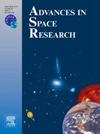Optical measurements of precipitating relativistic electron microbursts during geomagnetic disturbance and pulsating aurora
IF 2.8
3区 地球科学
Q2 ASTRONOMY & ASTROPHYSICS
引用次数: 0
Abstract
Mechanisms of formation and losses of radiation belts are the most important questions of magnetospheric physics, especially in a subsecond temporal scale. Energetic particles release their energy in the atmosphere producing fluorescent emission in characteristic wavelength bands. This emission is measurable and can be an additional information source on the spatiotemporal structure of particle fluxes and spectra. Here we present the world’s first measurements of UV-microbursts during geomagnetic disturbance and pulsating aurora caused by high-energy electron precipitation. It demonstrates that fundamental questions of magnetospheric physics mentioned above can be addressed by using the optical measurements by highly sensitive photometers with high temporal resolution. Such a photometer was installed at Verkhnetulomsky observatory at Kola Peninsula and measured a series of short (less than 0.5 s) pulses of emission with an angular size of bright spot 0.2 rad. Simultaneous measurements of high-energy electron fluxes made by the NOAA-19 satellite and fine temporal structure of geomagnetic pulsations demonstrate a magnetospheric origin of the observed events.
地磁扰动和脉动极光期间相对论性电子微暴的光学测量
辐射带的形成和损耗机制是磁层物理学中最重要的问题,特别是在亚秒时间尺度上。高能粒子在大气中释放能量,产生特征波段的荧光辐射。这种发射是可测量的,可以作为粒子通量和光谱时空结构的附加信息源。在这里,我们提出了世界上第一个测量紫外线微爆在地磁干扰和脉动极光引起的高能电子沉淀。这表明,利用高灵敏度、高时间分辨率的光度计进行光学测量,可以解决上述磁层物理的基本问题。这种光度计安装在科拉半岛的Verkhnetulomsky天文台,测量了一系列短(小于0.5 s)的发射脉冲,角尺寸为亮斑~ 0.2 rad。NOAA-19卫星同时测量的高能电子通量和地磁脉动的精细时间结构证明了观测事件的磁层起源。
本文章由计算机程序翻译,如有差异,请以英文原文为准。
求助全文
约1分钟内获得全文
求助全文
来源期刊

Advances in Space Research
地学天文-地球科学综合
CiteScore
5.20
自引率
11.50%
发文量
800
审稿时长
5.8 months
期刊介绍:
The COSPAR publication Advances in Space Research (ASR) is an open journal covering all areas of space research including: space studies of the Earth''s surface, meteorology, climate, the Earth-Moon system, planets and small bodies of the solar system, upper atmospheres, ionospheres and magnetospheres of the Earth and planets including reference atmospheres, space plasmas in the solar system, astrophysics from space, materials sciences in space, fundamental physics in space, space debris, space weather, Earth observations of space phenomena, etc.
NB: Please note that manuscripts related to life sciences as related to space are no more accepted for submission to Advances in Space Research. Such manuscripts should now be submitted to the new COSPAR Journal Life Sciences in Space Research (LSSR).
All submissions are reviewed by two scientists in the field. COSPAR is an interdisciplinary scientific organization concerned with the progress of space research on an international scale. Operating under the rules of ICSU, COSPAR ignores political considerations and considers all questions solely from the scientific viewpoint.
 求助内容:
求助内容: 应助结果提醒方式:
应助结果提醒方式:


